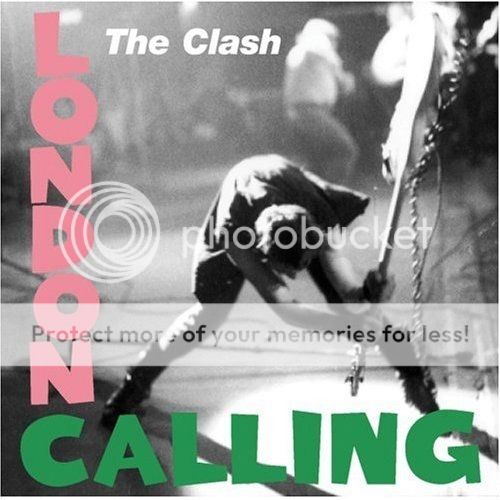When the Clash’s song “London Calling” was recorded in late 1979, punk rock had already peaked. To jolt the genre, the Clash combined punk with reggae, rockabilly and soul, resulting in one of the era’s most stirring and influential political rock anthems.
With its martial beat, rock-steady-funk bass line and lashing lyrics, the song warned about a world changing for the worse. Co-written by Mick Jones and the late Joe Strummer, the song “London Calling” never was a Billboard hit in the U.S.—though the album on which it appeared (and shares a title) did hit the charts in 1980 and has sold more than five million copies world-wide.
Recently, the band’s surviving original members Mick Jones, 58, Paul Simonon, 57, and Topper Headon, 58, talked about the song’s birth and development and the story behind the iconic photo on the album’s cover of Mr. Simonon smashing a bass guitar. Read the interview after the jump.
Mick Jones: The initial inspiration for the song “London Calling” wasn’t British politics. It was our fear of drowning. In 1979 we saw a headline on the front of the London Evening Standard warning that the North Sea might rise and push up the Thames, flooding the city. We flipped. To us, the headline was just another example of how everything was coming undone.
The punk anthem stemmed from The Clash’s fear of a flooded London.
Paul Simonon: In the ’70s, when we formed the band, there was a lot of tension in Britain, lots of strikes, and the country was an economic mess. There also was aggression toward anyone who looked different—especially the punks. So the name the Clash seemed appropriate for the band’s name.
Before “London Calling,” we didn’t really have a manager or rehearsal space, so we were drifting about. Our road crew found us space off Vauxhall Bridge Road in the Pimlico section along the Thames. It was a thin, drafty soundproof room upstairs in the back of a garage.
Mr. Jones: We rehearsed hard each day—taking a break in the afternoons to cross the road to a fenced-in playground where we played football. It was like team-building thing. We had a strong sense of togetherness.
[Lead singer] Joe Strummer was living in a building along the Thames and feared potential flooding. He did two or three drafts of lyrics that I then widened until the song became this warning about the doom of everyday life. We were a bit ahead of the global warming thing, weren’t we?
The line about phony Beatlemania biting the dust was aimed at all the touristy sound-alike rock bands in London in the late ’70s. We were fans of the Beatles, the Who and the Kinks—but we wanted to remake all of that. We wanted “London Calling” to reclaim the raw, natural culture. We looked back to earlier rock music with great pleasure, but many of the issues people were facing were new and frightening. Our message was more urgent—that things were going to pieces.
Once we had most of the words down, I began creating music to fit the rhythm of the lyrics. I wanted the urgency of a news alert. The two guitar chords I used were a bit jumpy at first but I figured out a trick with my little finger to change them smoothly.
Topper Headon: When Mick started playing the chords, I began drumming. My music background had been jazz and soul, so I wanted to give my martial tempo a bit of variety. I played the intro straight, but when the band and Joe’s vocal came in, I played 16ths on the high-hat with my right hand for some shimmer. Then when we started the chorus that began with “The Ice Age is coming,” I added a little swing thing.
Mr. Simonon: I wanted my bass line to be like a big declaration—like “Here we are!” My big influence was Leroy Sibbles, the bass player for the reggae band the Heptones.
Mr. Jones: The song’s title came from Joe. When he was a kid, his family had moved to Germany, and that’s where he first heard the phrase “London Calling,” on the radio. The BBC used it for years to open its news broadcasts abroad.
Mr. Headon: “London Calling” took weeks until we got it right. We weren’t in a great state financially and our third album had to sell or we were going to be in trouble with our record company. Making matters worse was our intention to do a double album, which didn’t go over well with the label. We had a lot riding on the work.
Mr. Jones: After “London Calling” was set—along with a batch of other songs for the album—we went into Bill Price’s Wessex Studios in August 1979. It was a former church in north London. Bill set us up in the studio in a tight circle.
Mr. Simonon: Our producer Guy Stevens was really important to us for his musical and emotional contribution. He was once asked to describe his style and he said, “In this world there are two Phil Spectors, and I’m one of them.” During the recording of “London Calling,” Guy would come into the recording room to intensify the mood. One time he came in while we were recording and started smashing chairs against the wall to increase the atmosphere. But not everyone was able to get out of the way. Joe was singing and playing the piano and Guy didn’t want it in there. He picked up a bottle of red wine and poured it all over Joe’s hands and onto the keyboard.
Mr. Jones: Most people aren’t aware that my guitar solo in the middle of the song is backward. After I recorded it, I turned the tape over and overdubbed it onto the mix that way. That’s why it whooshes. I wanted it to sound raw and unhinged.
Mr. Headon: Guy added the fire of magic. Look, when someone’s swinging a ladder around and you have to keep ducking, the music is definitely alive. At one point he said, “OK, that’s a take.” I said, “No, it’s not. It speeds up a bit.” He said, “All great rock ‘n’ roll speeds up. That’s a take.” And he was right. It made us realize that a good rock producer leaves imperfection in there someplace.
Mr. Jones: Bill Price is the one who added echo and the sound of cannons firing. We also added Joe making seagull cries that were influenced by Otis Redding’s “Dock of the Bay.” As musicians, you take the past with you, don’t you? The Beatles, Stones, Kinks and Small Faces had done something new and different and I wanted us to do that, too.
The Morse code thing at the end was me. I turned off one of my guitar pickups and used the remaining pickup to tack out the radio signal—to give it that BBC sound on the fade out.
Mr. Simonon: The photo of me on the “London Calling” album cover was taken while we were performing at New York’s Palladium Theater. The sound onstage was bad and I struggled to hear my notes. Also, most of the audience was sitting, so I assumed that either they didn’t like the show or that security wasn’t letting them dance. In frustration, I took it out on my bass guitar. Unfortunately, for the rest of the tour, I had to use my spare bass that didn’t sound as good as the one I had smashed. Photographer Pennie Smith took a photo. It was so quick and sudden—which is why the image of me smashing my bass guitar is blurry. Joe suggested we use Pennie’s photo for the cover of “London Calling” and we did.
My temper? It’s better now but not cured. It’s creative frustration triggered by whatever circumstance I’m in. I’ve got it almost under control but things do happen. Sometimes it’s hard counting backward from 20.
DOWNLOAD ON DMS


